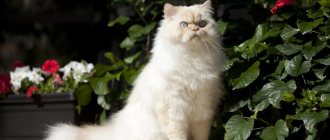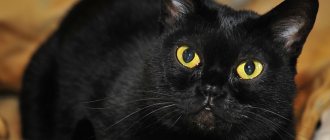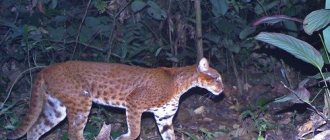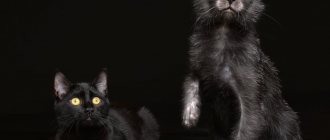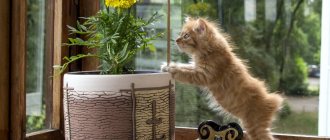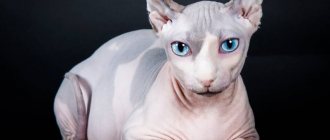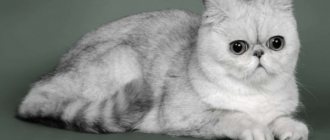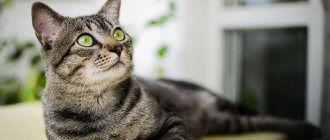Origin of the breed
Havana is a breed obtained by breeding Oriental cats. The unique cats have nothing to do with the island of Cuba; the breed appeared in the UK.
In the 19th century, unusual brown cats were brought to England from Thailand. The British enthusiastically accepted animals with the original “chocolate” color.
In Europe, Thai cats began to symbolize respectability and success. At English exhibitions, Oriental pets invariably attracted attention. In 1888, a representative of the breed even became the winner of one of the exhibitions.
Interesting! The Thai cat received the name Havana due to its original color. Its fur is the color of the tobacco in a Havana cigar.
During World War II, the population of unique cats almost disappeared. The British began to restore the breed. Since there are almost no purebred individuals left, breeders had to dilute the breed with a black European shorthair cat.
The crossing turned out to be successful. The cats received not only an attractive appearance, but also the endurance and strength of the European breed.
Some of the bred cats were sent to the USA, where breeding continued. The Americans took the matter seriously and did not dilute the breed with other species. As a result, the breed standard for the purebred Havana was established in the United States in 1958.
Appearance
The color of the Havana cat does not allow the presence of any other color other than brown. The pads on the paws are pink, as is the tip of the nose. The eyes are bright green. This eye color harmonizes perfectly with brown. A cat's large ears always point forward.
Kittens may have colored markings, but in purebred individuals these should disappear over time.
There is a version that the most thoroughbred representatives of Havana have Swiss roots.
Description of the breed standard
Havana is a medium-sized breed. Females are lighter than males, the former weigh 3–4 kg, the latter – 4–5 kg. Despite its graceful physique, the cat’s weight is quite large, which is due to its strong skeleton and developed muscles.
The Havana cat breed standard is shown in the table.
| head | elongated, narrow, high cheekbones, with an arched profile and a large chin, the angle between the forehead and nose is not pronounced |
| eyes | large, almond-shaped, slightly slanted, the color of the iris is all shades of green |
| ears | large, spaced far apart, with a wide base and sharp ends, slightly inclined forward |
| torso | elongated, lean, sinewy, dignified, harmoniously built, with a tucked belly and narrow chest |
| limbs | long, dry, the hind legs are slightly longer than the front ones, the paws are small, oval |
| tail | long, thin along the entire length, whip-like |
| wool | short, velvety to the touch, shiny |
Colors
Havana cats come in two types of color:
- Havana Brown - red-brown, a mixture of chocolate and mahogany color;
- Havana lilac is a warm pinkish-gray color.
Vibrissae are colored in the same way as wool. The nose and paw pads are pinkish-brown. Spots and patterns on the body are unacceptable.
Interesting! Many Havanese kittens are born spotted. But the spots disappear when the cubs reach one year of age.
Photo of Havana cat
Read here The Nibelung cat breed - an overview of the breed, nuances of character and tips for caring for a cat (125 photos)
Help the site, share with friends 
Character and temperament
Havana is an active, intellectually developed cat. She does not tolerate loneliness and lack of attention from her master; she is interested in everything that family members do.
Havana is playful, inquisitive, willingly interacts with children and strangers, and participates in children's games and amusements. Therefore, it is recommended to have a pet for large and friendly families who spend a lot of time at home.
A person who rarely appears at home should not get a cat. The animal suffers from loneliness, begins to rage, turn everything upside down, tear up furniture and curtains. An option to solve the problem is to get a second cat of the same breed, then the pets will not be bored without communication.
The Havana cat is talkative and accompanies its every action with a purr. Loves to communicate with the owner and be caressed. Havana is intellectually developed, without any problems he gets used to the tray, scratching post, and rules of behavior in the house. It is not difficult to accustom her to a leash so that she can be taken for a walk.
Oriental cats are jealous, strive to show off in front of the owner, to lead over other domestic animals. If there is a Havana in the house, then you should not buy a puppy: the pet will not get along with it.
Havan character traits
These pets have a friendly and sociable character. But they do not have the obsession inherent in the Siamese.
Havana cats are quite active and mobile, but within reasonable limits. Alone, they will rather sleep than happily destroy the apartment, as their Siamese ancestors do.
The animal sincerely loves the owner and all household members, becomes very attached to them and does not tolerate separation well. It is much easier to take your pet on a trip with you; he loves to travel and will happily sit in a carrier in the car.
This cat is not jealous and easily shares its love for its owner with other pets.
Health and disease prevention
The Havana cat has a strong body; with proper care, illnesses rarely occur. Pets live up to 15 years.
From its Siamese ancestors, the Havana Brown received a tendency to several hereditary pathologies:
- cardiomyopathy;
- impaired renal function, urolithiasis (in old age);
- disruption of the functional state of the pulmonary system;
- ulcerative and inflammatory pathologies of the oral mucosa.
Havana is vaccinated annually against calcivirosis, rhinotracheitis, panleukopenia, and rabies. At the time prescribed by the veterinarian, the animal is given drugs to treat helminths.
Care and maintenance
The cat requires minimal grooming due to its short fur. Brushing once or twice a week and good, premium cat food is all that is required for her to feel great. Periodically you need to trim overgrown claws and check the cleanliness of the ears.
There are currently no known genetic diseases to which cats of this breed are prone. The only thing is that they have gingivitis a little more often, which is apparently inherited from the Siamese cat.
Care instructions
The Oriental breed does not have an undercoat, so grooming is not difficult. Brush the coat once a week. Bathe your pet infrequently, only when the coat becomes dirty. Use universal zoo shampoo or baby soap. After bathing, dry the body with a towel; do not use a hairdryer, otherwise the delicate coat will dry out.
Eye tears are wiped every day with a napkin moistened with boiled water. The ears are cleaned once every 2 weeks with a cotton swab soaked in veterinary lotion. Teeth are brushed once a week with veterinary paste. As they grow, the claws are shortened with a nail clipper if the cat is not accustomed to a scratching post from an early age.
Important! The kitten is fed 5 times a day; as it grows, the daily number of servings is reduced. After reaching one year of age, the kitten should eat 2 times a day.
The Havana diet is standard, balanced, including vitamin supplements. Representatives of the breed are not capricious in their diet. You can feed your cat both store-bought super premium food and natural food. In the first case, the animal is given not only dry, but also wet canned food. In the second case, the share of meat food in the diet should be at least 70%.
Where and for how much can you buy Havana?
There are about a hundred purebred cats of this breed in the world. The price for Havana will be quite high. The cost for kittens starts from $900.
The Havanese breed is hard to find in the world. There are no nurseries either in the CIS regions or in other parts of the world. True, you can always read advertisements, maybe someone will breed these cats. First, you definitely need to find out the pedigree and inquire about the veterinary passport.
Popular kennels for this breed:
- Russia - (your nursery is here);
- Belarus - (take place);
- Ukraine - (submit an application).
Story
Like most famous breeds, the Havana Brown's homeland is Thailand. The cat left traces of its existence and was recorded in the book “Poem about Cats” and reproduced in the form of sketches on pages between 1350-1767. They have a beautiful solid coat color and clear green-blue eyes. There is an opinion that it was the color that gave rise to the name of the breed, since the resemblance to the famous cigar is obvious. Information about brown animals dates back to 1800, but the English deserved the right to be considered the discoverers of the breed. By crossing chocolate Siamese, seal point and domestic black shorthair cats, we managed to achieve the desired, stunning effect.
The breed was registered in 1958, therefore, England is rightly considered the homeland of the Havana. During this period of time, some of the cats were exported to America for improvement and breeding. The genetics were disrupted by the dilution of the English breed by others, and this affected the shade, but the USA managed to maintain the original color. This led to the division into chestnut orientals (different shades of brown) and havana browns.
Asian tabby - description of the breed and character of the cat
Gentle and active at the same time
Havanese cats are curious, cheerful and playful because they are always looking for attention and activity. If you do not receive them, you will notice that they are being requested by you.
Havanese cats easily adapt to different situations. Although they are very active, they can also be kept as a house cat when they are working properly.
This may also interest you:
Khao Manee Cat: white stone
like an open and confident cat, She especially often bonds with one of the person's family members: will you be the one or the lucky one?
Choosing a Havana Brown kitten, price
It is better to buy kittens from a nursery registered with one of the felinological associations. Children must have documents confirming their origin. The living conditions and appearance of all cats in the nursery will tell about the responsibility of the breeder and the health of the livestock. Kittens and young Havanas may have subtle tabby markings on their fur: rings on the tail, stripes or spots on the body. With age they disappear, the color becomes clear and uniform.
The Havana is a very rare breed; there are less than 1,000 cats in the world. The main population is concentrated in the United States and Western Europe.
Many organizations, particularly the CFA, allow interbreeding in their breeding programs to improve appearance and genetic diversity. Most often they are crosses with oriental cats. Kittens from such matings with a standard color and appearance can be registered as Havana.
The cost of a Havana kitten in nurseries in the USA and Europe is approximately in the same range from 500 to 1000 dollars. Owned kittens usually cost no more than $200.



